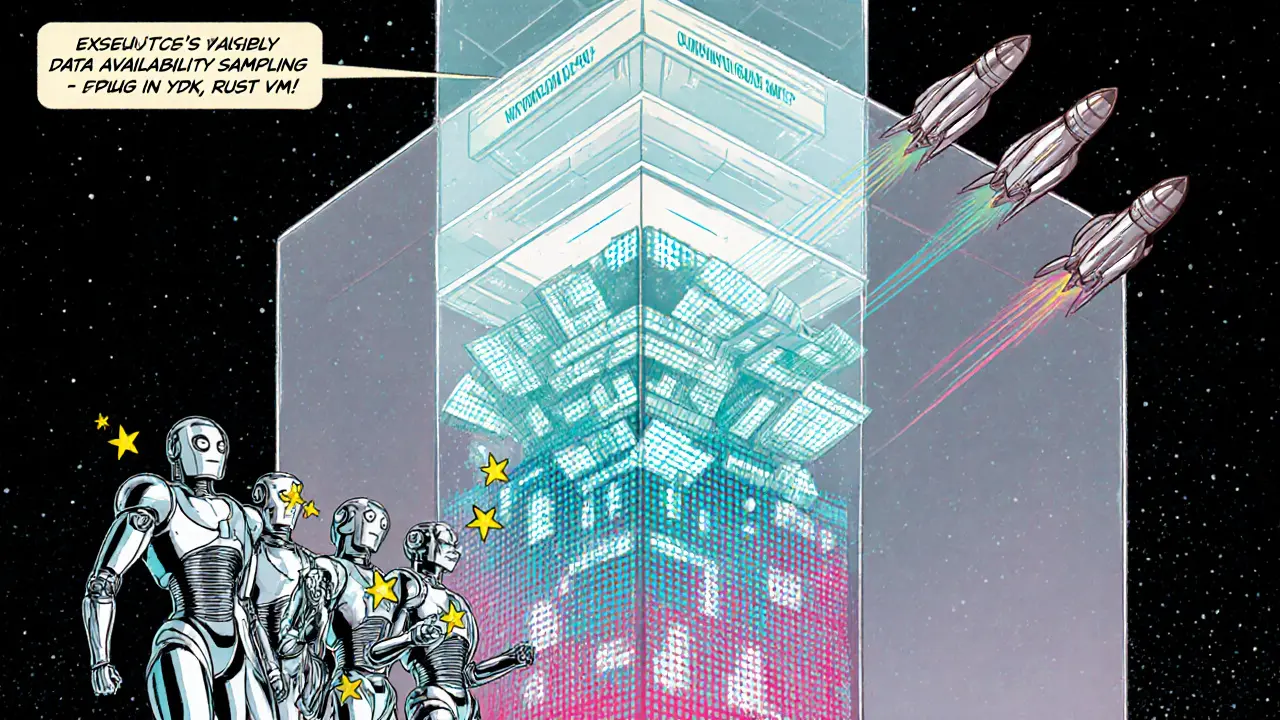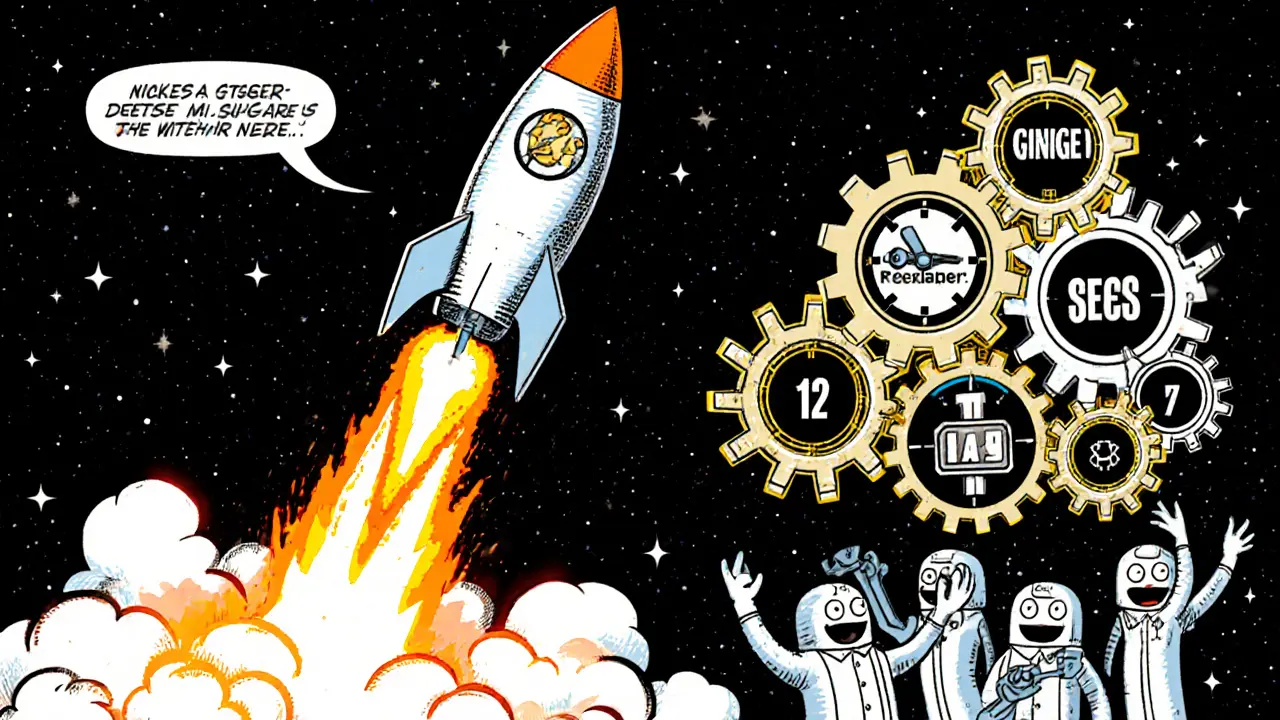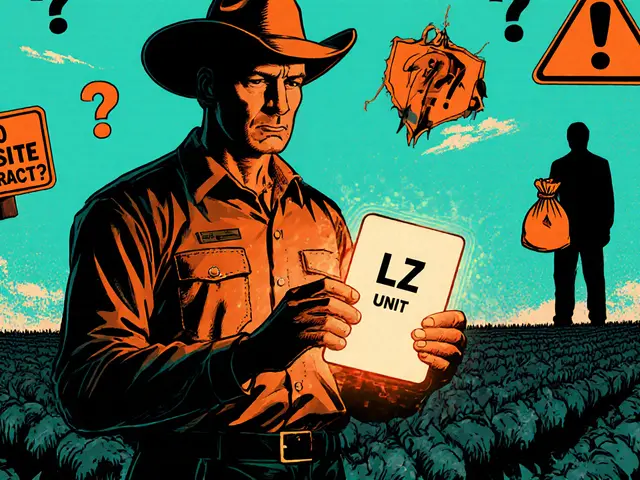
Data Availability Sampling Calculator
Calculate Your DAS Confidence
See how many random samples are needed to verify data availability with Celestia's Data Availability Sampling (DAS).
Why This Matters
Celestia's DAS lets light nodes verify data availability without downloading entire blocks. This enables efficient, decentralized verification for rollups.
Results
How It Works
Each random sample gives 50% confidence. With n samples, confidence = 1 - (0.5)n.
Light clients only download 1 sample per shard instead of the entire block, saving bandwidth while maintaining security.
When you hear the word Celestia, picture a blockchain that does one thing and does it really well - provide consensus and data availability - while handing off execution to whatever rollup or app you build on top. That split is what makes it a modular blockchain and why developers are suddenly looking at it for the next generation of scalable Web3 projects.
Why a Modular Design Matters
Traditional chains like Bitcoin and Ethereum pack consensus, execution, settlement, and data availability into a single layer. When transaction volume spikes, every node must process the whole block, leading to the classic trilemma of decentralization, security, and scalability.
Celestia throws out that monolithic model. By isolating the data availability function, it lets rollups pick the execution environment that best fits their use‑case - be it an EVM, a Cosmos SDK app, or a custom VM written in Rust. The result is a network that can stay decentralized even as the number of rollups explodes.
The Three‑Layer Blueprint
Celestia’s architecture is built around three logical layers:
- Consensus Layer - validators agree on the order of blocks using a Proof‑of‑Stake (PoS) algorithm. This layer guarantees finality and security.
- Data Availability Layer - the real star of the show. It uses Data Availability Sampling (DAS) so a lightweight node can be sure the block’s data is present without downloading the whole thing.
- Execution Layer - deliberately omitted. Developers plug in their own rollup or execution environment, which reads the data from Celestia and validates transactions locally.
This separation lets validators stay light, while developers enjoy full freedom to design custom chains.
Key Technologies Powering Celestia
Two innovations make the data‑availability‑only model both secure and efficient.
Data Availability Sampling (DAS)
Instead of storing every byte, a node requests a few random shards of the block. Because Celestia encodes data with erasure coding, even a tiny sample can prove that at least 50% of the shards are present. One sample gives about a 50% confidence level; seven random samples push confidence over 99% - enough for a node to safely consider the block available.
Namespace Merkle Tree (NMT)
The NMT splits a block into namespaces. Each dApp or rollup gets its own namespace identifier, meaning a node only needs to pull the Merkle proofs belonging to its namespace. This dramatically reduces bandwidth and storage for light clients, because they never see unrelated traffic.

Building Rollups on Celestia
Rollups are essentially sidechains that post their state roots to a base layer. On Celestia, a rollup publishes its blocks to the Data Availability Layer, and any light node can verify those blocks using DAS and NMT. The benefits are clear:
- Custom execution: Choose Solidity, Rust, or any language; the rollup runs its own VM.
- Scalability: Since Celestia doesn’t execute transactions, the rollup can push throughput limits without congesting the base layer.
- Security: The base layer’s PoS consensus and DAS proofs protect the rollup’s data, while fraud proofs keep execution honest.
Early adopters include Ethereum‑compatible rollups* that want fast data availability without paying Ethereum gas, and Cosmos‑based application‑specific chains that need a reliable sharding‑friendly data layer.
Celestia vs. Traditional Monolithic Chains
| Feature | Celestia | Ethereum | Bitcoin |
|---|---|---|---|
| Primary Function | Data availability + consensus only | Consensus + execution + data availability | Consensus + data availability only |
| Execution Layer | External rollups (EVM, Cosmos SDK, custom) | Built‑in EVM | None (script limited) |
| Consensus Mechanism | Proof‑of‑Stake | Proof‑of‑Stake (post‑Merge) | Proof‑of‑Work |
| Data Availability Proofs | Data Availability Sampling (DAS) | Full block download for validation | Full block download for validation |
| Block Time (as of 2025) | 6 seconds (Ginger upgrade) | ≈12 seconds | ≈10 minutes |
The table highlights why developers who need high throughput and cheap data publishing are gravitating toward Celestia - they get PoS security and DAS proofs without the execution bottleneck.
Recent Milestones: The Ginger Upgrade
On 25Oct2024 Celestia announced the Ginger upgrade, a hard fork that cut the block interval from 12seconds to 6seconds. The upgrade, rolled out on mainnet in Dec2024, also introduced optimized erasure coding parameters, giving a 15% reduction in bandwidth for light clients. Faster blocks mean rollups can commit state roots more often, translating into lower latency for end users.
Beyond speed, Ginger added optional parallel block processing for validators, allowing them to verify multiple DAS proofs simultaneously. Early test‑net data shows a 30% increase in transaction throughput for rollups that batch many small transfers per block.

Getting Started: Tools and Resources
If you’re a developer eyeing Celestia, here’s a quick checklist:
- Set up a node: Use the official
celestia-nodebinary (available for Linux, macOS, Windows). Light nodes only need a few GB of storage thanks to DAS. - Choose a VM: For EVM compatibility, deploy an Ethereum rollup on Celestia using the
evm‑on‑celestiaSDK. For Cosmos‑style chains, thecelestia‑cosmos‑sdkbridge lets you write modules in Go. - Write smart contracts: Solidity contracts compile as usual; just point the deployment script to the Celestia rollup’s RPC endpoint.
- Test data availability: Run the
das‑testertool to simulate random shard requests and verify your rollup’s data can be reconstructed with <90% confidence. - Monitor health: The Celestia Explorer shows block times, validator uptime, and DAS verification rates in real time.
All of these resources are bundled in the Celestia “Dev Kit” released Q12025, which includes Docker images, sample rollup templates, and step‑by‑step tutorials.
Future Outlook: The Role of Modular Blockchains
Investment numbers speak loudly: $55million raised in SeriesA/B, a $1billion unicorn valuation, and backing from Coinbase Ventures, Jump Crypto, and others. The market analysts see Celestia as the backbone for the rollup boom - as more DeFi, NFT, and gaming projects demand low‑cost data storage, a modular data availability layer becomes essential.
Beyond finance, enterprises are experimenting with private rollups that write compliance data to Celestia, leveraging its immutable data guarantees without exposing their execution logic. As the ecosystem matures, you’ll likely see hybrid solutions where a single rollup bridges multiple VMs, all anchored on the same data‑availability network.
Frequently Asked Questions
What exactly does Celestia provide that other blockchains don’t?
Celestia offers a dedicated data‑availability and consensus layer while leaving execution completely open. This means developers can attach any virtual machine or rollup they want, and light nodes can verify data with DAS without storing the whole chain.
How does Data Availability Sampling improve scalability?
DAS lets a node request a handful of random shards from a block. Because the block is erasure‑coded, those few shards are enough to prove that the rest of the data exists. Nodes therefore avoid downloading megabytes of data, saving bandwidth and storage while still providing cryptographic guarantees.
Is Celestia compatible with existing Ethereum tools?
Yes. The Celestia Dev Kit includes an EVM‑compatible rollup template that works with Hardhat, Truffle, and Metamask. You deploy contracts as usual and point the RPC URL to the Celestia rollup endpoint.
What is the Ginger upgrade and why should I care?
Ginger cut Celestia’s block time from 12seconds to 6seconds and refined erasure coding. Faster blocks mean rollups can finalize state more often, which lowers transaction latency for end users and improves overall network throughput.
Do I need expensive hardware to run a Celestia validator?
Validators still need to stake TIA and run a full node, but because the node only stores availability proofs (not full execution data), the storage requirement is under 500GB. CPU and bandwidth needs are comparable to other PoS networks.






There are 9 Comments
Hanna Regehr
Celestia’s separation of consensus and data availability really changes how we think about building scalable blockchains.
By offloading execution to rollups, developers can pick the VM that best fits their application without overloading the base layer.
The Data Availability Sampling mechanism ensures that even a light node can verify that a block’s data is present by sampling just a handful of shards.
Because the underlying erasure coding spreads data across many nodes, the probability of missing a missing shard drops dramatically with each additional sample.
In practice, seven random samples push confidence above 99 %, which is more than enough for most security models.
This means bandwidth consumption drops by roughly ninety‑three percent compared to downloading the full block.
For rollup operators, this translates into lower transaction fees and faster finality for end users.
The recent Ginger upgrade shaved the block time down to six seconds, so state roots can be posted more frequently.
Parallel block processing also lets validators verify multiple DAS proofs at once, boosting throughput by around thirty percent.
From a developer standpoint, the modular approach lets you integrate existing tooling, whether you’re using the evm‑on‑celestia SDK or the Cosmos SDK bridge.
You can spin up a light node with just a few gigabytes of storage, which lowers the barrier to entry for testnets and community validators.
Security isn’t compromised either; the PoS consensus layer secures the data availability proofs, and fraud proofs keep execution honest on the rollup side.
If you’re concerned about data availability attacks, remember that the NMT namespaces isolate each rollup’s data, so a malicious actor can’t flood the network with irrelevant traffic.
Moreover, because each namespace has its own Merkle proofs, light clients only fetch the data they actually need.
Overall, the design encourages a healthier ecosystem where specialised execution environments can coexist without contending for the same resources.
If you’re just getting started, the das‑tester tool is a great way to simulate shard sampling and verify that your rollup’s data can be reconstructed reliably.
Lena Vega
The summary captures the key benefits of modular data availability succinctly.
Laura Myers
Wow, Celestia is basically rewriting the rulebook on blockchain architecture!
It’s like watching a magician pull a rabbit out of a hat while the audience thinks they’re just getting a boring card trick.
The way DAS lets light nodes prove data presence with just a few samples feels like a sci‑fi hack straight out of a cyberpunk novel.
All this hype is totally justified, and the data‑availability‑only model could be the blockbuster sequel we’ve been waiting for.
Anjali Govind
It’s exciting to see how modular design opens the door for any VM to plug into the same data layer, and the NMT namespace isolation really helps keep traffic tidy.
The flexibility means developers from different backgrounds can collaborate without stepping on each other’s code.
Seeing the Ginger upgrade’s impact on block times also shows that the network is still evolving fast.
Sanjay Lago
Honestly this looks really promising and I think the community will love it.
The DAS concept is simple yet powerful – you only need a few samples to feel safe.
Plus, the new block speed with Ginger is definetly a game changer for rollups.
Keep exploring and you’ll see how easy it is to get started with a light node.
Annie McCullough
Sure, modular chains are the future but don’t forget the trade‑offs - complexity can creep in quickly 😏
Carol Fisher
🇺🇸 It’s about time we support a home‑grown solution that puts security first and doesn’t rely on foreign blockchain experiments 🙌🦅
Melanie Birt
For anyone still unsure, start by running the official celestia‑node binary and use the das‑tester to validate data availability – it’s a solid first step 😊
Lady Celeste
The hype is overblown; most rollups will still face scaling limits.
Write a comment
Your email address will not be published. Required fields are marked *